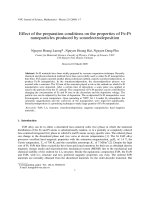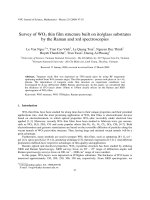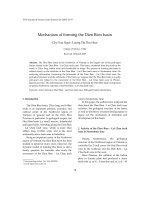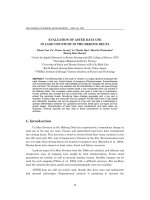Tài liệu Báo cáo " Determination of the annual beta dose by meaming beta activity using the liquid scintillation technique " ppt
Bạn đang xem bản rút gọn của tài liệu. Xem và tải ngay bản đầy đủ của tài liệu tại đây (329.15 KB, 6 trang )
VNU Journal of Science, Mathematics - Physics 24 (2008) 36-41
36
Determination of the annual beta dose by meaming beta
activity using the liquid scintillation technique
Nguyen Quang Mien
1
, Bui Van Loat
2,*
1
Institute of Archaeology, 61 Phan Chu Trinh, Hoan Kiem, Hanoi, Vietnam
2
College of Sciences, VNU, 334 Nguyen Trai, Thanh Xuan, Hanoi, Vietnam
Received 3 August 2007; received in revised form 28 March 2008
Abstract. This paper presents a method for measuring the gross alpha/beta radioactivity of ancient pottery by
using the liquid scintillation technique, Tri - carb2770TR/SL in the alpha/beta discrimination counting mode.
The beta radioactivity is converted to the annual dose, which can be applied in dating of pottery by
thermoluminescence technique. In comparision with the radiocarbon technique, the preliminary results shown
that the liquid scintillation technique may be applied effectively for ancient ceramic dating in Vietnam.
Keywords: Environmental radioactivity, Dosimeter, Thermoluminescence Dating
1. Introduction
Pottery is one of the most important archaeological relics to study on ancient cultures and art
histories. Every civilized culture had left some earthen wares featured by their characteristic forms, shapes,
designs, materials and other technical (stamps) imprints. Hence, forms and materials are normally used to
categorize earthenware by culture and period accordingly. This is particularly important for the
archaeological investigation of prehistoric periods, where human culture could not yet be characterized by
the written letters remained. The pottery’s age is an important term, therefore, if there are more
scientifically founded methods to date ancient pottery, the categorization of cultural periods will be more
precise. One of the reliable methods to date archaeological pottery is the thermoluminescence method (TL),
which is effectively applied in many countries all over the world [1,2].
In the natural environment, the ionizing radiations from the radioactive elements contained in
soils causing effects on the material’s properties of ancient pottery samples. Natural ionising radiation
consist of the alpha, beta and gamma irradiations.These irradiations cause the different effects on the
thermoluminescence behaviour of the materials. For example, among all the irradiations, the alpha
particles, cause effects only on fine grains due to their short penetration length (10 ÷40µm) although
their high ionizing capacity. The beta and gamma irradiation, however, are the main agents to cause
thermoluminescence phenomena in large quartz grains due to their very longe penetration length,
although their lower ionizing capacity. Hence, to date ancient pottery by the quartz inclusion
technique, the determination of the beta annual dose plays a determining important role on the
precision of method. We have following formula:
______
*
Corresponding author. E-mail:
N.Q. Mien, B.V. Loat / VNU Journal of Science, Mathematics - Physics 24 (2008) 36-41
37
β γ
0 9
=
+ +
c
P
A
. D D D
(1)
where A is thermoluminescence age of pottery (in years -yr); P is the paleodose in sample (Gy); D
β
is
annual beta dose (Gy/yr); D
γ
is annual gamma dose (Gy/yr); and D
C
is anual cosmic dose, which is
around 175 µGy/yr) [1-3].
Presently, in the ancient pottery TL dating the following steps for the determination of annual
dose rate are: (i) place the thermoluminiscnece dosimeter at the field; (ii) determine the environmental
radioactivity of a representative soil sample for the region concerned and (iii) determine the contents
of radioactive elements, such as uranium, potassium and thorium in the soil sample. In general, these
measuremend procedures shown essential disadvantages, such as: registration time is long, low
accuracy and sophisticated equipment is required. Therefore, a new method (procedure), presented in
this paper which allows quick and accurate avaluattion of the gamma and beta annual dose, will
contribute to the significant improvement for the thermoluminescence pottery technique in Vietnam.
In previous research works [5,6], we have presented a procedure to evaluate the environmental
gamma dose rate by using the radiometer of the type CΡΠ-68-01 (Figure 1).
The instrument used in this experiment is CΡΠ-
68-01 (USSR). A cylinder-shape detector NaJ(Tl) of
the size 30mm x 30mm, allowing to measure the
energy in range from 50keV to 3000keV. In the
practice, such stable and highly sensitive equipment
was used to determinate the annual gamma dose in
thermoluminesccence dating.
In the consistency with the experimental results
it was shown that the more accurate the beta dose
evaluation is, the more reliable is the technique of
thermoluminecence dating [5,6].
Fig. 1. the measurement of the gamma dose rate
using the radiometer CΡΠ-68-01.
This paper presents a new method to evaluate the annual beta dose (D
β
)by measuring the gross
beta activity using the liquid scintillation analyzer Tri-carb 2770TR/SL.
2. Experimentals, results and discussion
The sample preparation procedure for measuring by liquid scintilation technique is presented in
Figure 2
N.Q. Mien, B.V. Loat / VNU Journal of Science, Mathematics - Physics 24 (2008) 36-41
38
Fig. 2. The scheme of sampling preparation.
The scintillation measurement was carried out on a liquid scintillation analyzer, Packard Tri-
carb 2770TR/SL (UsA), which is shown in Figure 3.
The liquid scintillator used in the
experiment was of the Ultima Gold AB series
of DIN–based cocktails. This cocktail was
designed specifically, for alpha/beta
separation, by the Packard Instrument
Company with an aqueous concentration of
approximately 25% and can effectively detect
both of alpha and beta particles at the same
time [3].
Fig. 3. Measurement the total beta radioactivity by LsA
Tri-carb 2770TR/sL.
The total alpha/beta activity in ancient pottery were measured with the Tri carb 2770TR/SL in
the alpha/beta discrimination counting mode. The high percentage of triplet states produced by alpha
particles were translated into electronic pulses at the PMT anode which may be as much as 30 nsec
longer than those derived from beta particles and gamma photons produced in the sample cocktail.
This is illustrated graphically in Figure 4.
N.Q. Mien, B.V. Loat / VNU Journal of Science, Mathematics - Physics 24 (2008) 36-41
39
In order to optimize alpha/beta
separation performance, it is necessary to
determine the correct PDD (Pulse Decay
Discriminator) setting. The optimum setting
is the setting where there is equal and
minimum spill of alpha pulses into the beta
MCA and beta pulses into the alpha MCA. In
the Parkard Tri-carb 2770TR/SL the
spillover percentage or misclassification
percentage of Am-241 and Cl-36 samples is
less than 0.5%.
Fig. 4. Characteristic light pulse shapes of alpha and beta
pulse in a liquid scintillator.
In theory, the alpha events should be sent to the alpha MCA and the beta events to a beta MCA,
negating the requirement for spectral overlap calculations.
In this experiment, nine pottery samples collected from three archaeological sites at three
different provinces were evaluated for the annual beta dose as the following: GoThap located in Tan
Kieu commune (Thap Muoi district Dong Thap province); BaiBen located in Hien Hao commune (Cat
Hai district, Hai Phong City); ThapBa located in Nha Trang town (Khanh Hoa province). At each site
samples were chosen with the same identification, i.e. with the coarse material consisting of sand,
and their ages have been determinated by the radiocarbon method [5].
- GoThap two values were obtained: 2150±130 and 1990 ±115 yrBP
- BaiBen two values were obtained: 3450±120 and 3540 ±140 yrBP
- ThapBa two values were obtained: 1450±125 and 1340 ±115 yrBP
Besides, for all pottery samples collected at each of the above locations, the regional gamma
radioactivity from surrounding terrestrial environment and cosmic irradiation was predeterminated
using the portable radiometer CPП-68-01. The results as obtained are shown in the Table 1. The total
specific beta activity in pottery was calculated based on the standard ThS sample and caculated data
are also included in Table 1.
Table 1. The measured results of the beta and gamma radioactivity
Sites
Beta specify activity
*
(C
β
) Gamma dose rate (Iγ)
(Bq/kg) (µR/h)
GoThap 1320 ± 50 17.0 ± 0.5
BaiBen 1084± 52 10.5 ± 0.5
ThapBa 1380 ± 48 17.0 ± 0.5
*)
averaged in three counting.
The annual dose of beta (mGy/yr) was evaluated from: D
β
= 2,22.10
-3
.C
β
and
that of
gamma
(mGy/yr) from: D
γ
= 0.1752.I
γ,
where C
β
is the specify activity of beta (Bq/kg), and (I
γ
) is gamma dose
rate (µR/h).
Water in the pore of pottery or in the soil absorbs some parts of the radiation that would
otherwise reach the thermoluminescent grains. Alternatively, on the infinite matrix basis, one can
N.Q. Mien, B.V. Loat / VNU Journal of Science, Mathematics - Physics 24 (2008) 36-41
40
think of the water as decreasing the radioactivity per unit mass compared to the dry situation.
Consequently, if the dose-rates have been evaluated from measurement on the dry material, the
corrected values to be used in the age-equation are given by [1,2]:
D
β
= D
β,dry
/(1+1.25 WF) (2)
D
γ
= D
γ,dry
/(1+1.14 W
1
F) (3)
where, D
βdry
and D
γ,dry
are the dose-rates to be evaluated for dry materials by beta or gamma
respectively, W and W
1
are the saturation water contents expressed as (weight of water/dry weight)
for pottery or soil, respectively; F is the fraction of saturation to which the assumed average water
content corresponds.
With the values given as: W = 0.2; W
1
= 0.2 and F =0.8, the corrected values were calculated
for the annual gamma and beta dose of pottery in TL dating by quartz inclusion technique. The
obtained results are presented in Table 2.
Table 2. The annual dose in pottery for dating by quartz inclusion technique
sites Annual beta dose rate (D
β
) (mGy/yr) Annual gamma dose rate (D
γ
) (mGy/yr)
GoThap 2.344 ± 0.089 2.283 ± 0.073
BaiBen 1.925 ± 0.092 1.284 ± 0.073
ThapBa 2.451 ± 0.085 2.283 ± 0.073
The equivalent dose (Q) was evaluated applying the additive dose method: The
thermoluminescence intensities of the samples were measured after the exposure to the radiation from
radioisotope cobalt-60 source source at known dosages as: 1Gy, 2Gy and 3Gy; 5Gy, 10Gy and 20Gy.
Results are plotted in Figure 5.
Fig. 5. The additive dose method for evaluation of the paleodose.
The paleodose P that the sample has received during antiquity is usually greater than Q because
of the pre-dose effects [1,2]. The evaluation of this correction is presented in Figure 5b. Thus, the
paleodose is calculated as P= Q + I; The results are shown in Table 3.
From the value of cosmic irradiation (2µR/h) and the annual dose-rates presented in Table 2, the
thermoluminescence dating of pottery are calculated (see Table 3).
N.Q. Mien, B.V. Loat / VNU Journal of Science, Mathematics - Physics 24 (2008) 36-41
41
Table 3. The paleodoses and thermoluminescence ages
Sites Paleodose (Gy) TL age (year)
GoThap 9.03 ± 0.26 2056 ± 109
BaiBen 10.02 ± 0.29 3322 ± 216
ThapBa 5.56 ± 0.15 1239 ± 69
A comparison between the obtained thermoluminescence ages and the radiocarbon ages is
presented on the Figure 6.
The results in Figure 6 indicate that, the
TL ages of ancient pottery determined by the
quartz inclusion technique were a good
agreement with the radiocarbon ages as well as
the approximate dates in archaeology, which
were the early bronze period (BaiBen), and
some AD begining centuries (GoThap), and
from 8
th
-11
th
AD centuries for ThapBa [7].
Fig. 6. Comparison the TL ages and
14
C ages.
3. Conclusions
The procedure of sampling preparation and measurement for the total alpha/beta radioactivity in
ancient pottery using the liquid scintillation technique using Tri-carb 2770TR/SL with cocktail Utima
Gold AB is presented. Based on the results obtained from the mesearement the annual beta dose rates
were evaluated and applied in thermoluminisecence dating of ancient pottery samples collected from
three archaeological sites. The TL ages obtained are compared with the radiocarbon ones. Preliminary
results illustrate that the determination of the annual beta dose using the liquid scintillation
technique Tri-carb 2770TR/SL can be considered as a high sensible and accurate method in
archaeological sample dating. Only a low-mass of sample is required. This method is quite suitable
for thermoluminescence dating of the ancient pottery in Viet Nam.
Acknowledgements. This work is supported financially by QG-07-06 Project.
References
[1] M.J. Aitken, Thermoluminescence Dating. Research Laboratory for Archaeology and History of Art. Oxford University
Press, England, 1985.
[2] S. Fleming, Thermoluminescence Techniques in Archaeology. Oxford Science Publications, England, 1979.
[3] J. Charles, Jr .Passo, T. Gordon, Cook, Handbook of Application the liquid scintillation counting in environment.
Packard Company Published, 1996.
[4] IAEA-TECDOC-566, The use of gamma ray data to define the natural radiation environment. IAEA,Wienna, 1990.
[5] Nguyen Quang Mien, Dating the ancient pottery by radiocarbon. The report of researching project in Archaeological
Institute, 2004.
[6] Nguyen Quang Mien, Bui Van Loat, Le Khanh Phon, Determination annual dose in thermoluminescent solids by portable
radiometer CPΠ-68-01. Proceeding of the 14
th
Conference, University of Mining and Geology, Hanoi, 17
th
November
(2004) 50.
[7] Ha Van Tan (Chief Ed.), Archaeology of Viet Nam, The Publisher of Social Science, 2002









